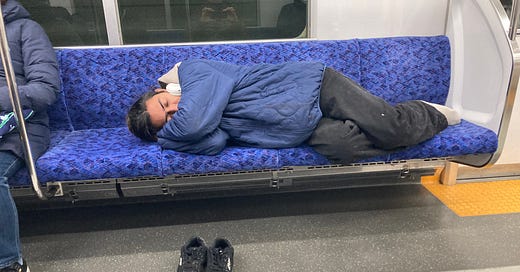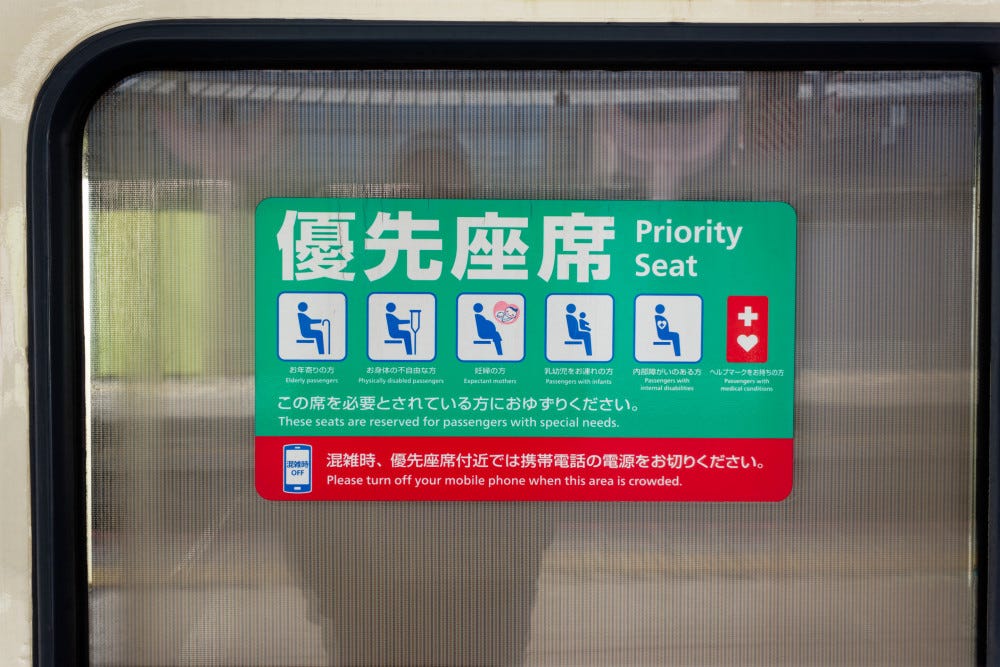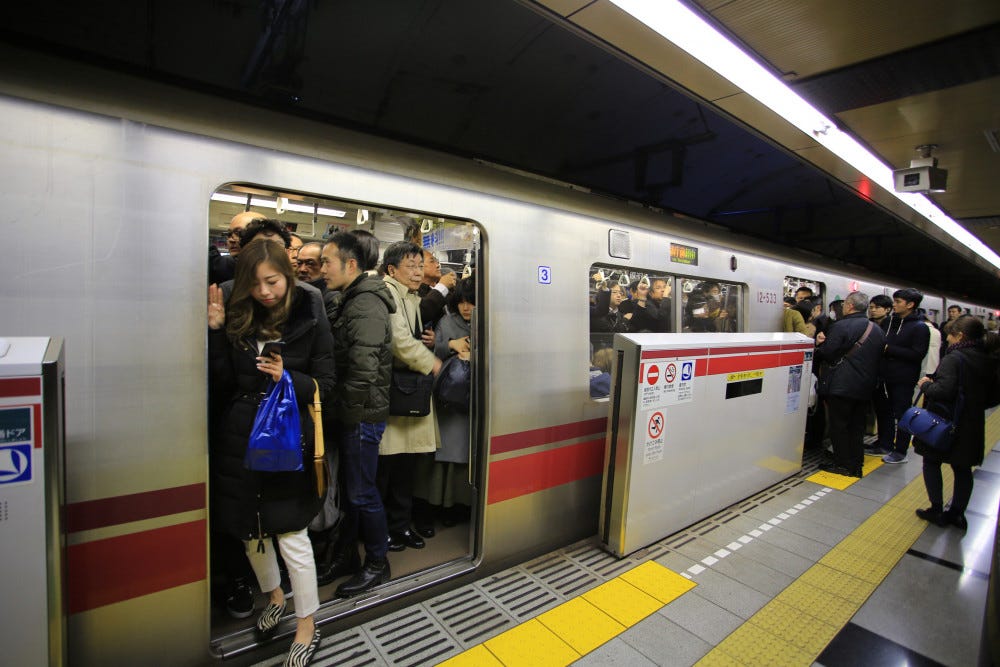Although the current series focuses on the Yamanote Line, the following advice is valid on any local train in Japan.
Don’t forget the special 80% discount on annual paid subscriptions.
$30 → $6 (see link above)
Here’s a chance to support Tokyo Calling for cheap.
Riding trains in Japan requires a certain approach. The locals usually go to great lengths not to bother the people around them, and this is even truer in closed spaces, like on a train. Causing disruption to shared spaces is a cardinal sin in Japan.
Let’s see what the key rules and etiquette are.
In most cases, you’ll better follow those rules, but sometimes there’s room for flexibility. Let’s say that some things are expected, and some are optional.
So let’s get on the train. No matter what time of day (even during rush hour in Tokyo) inside it’s quiet despite the packed crowd. No loud chatter, no blasting music. The most irritating thing are actually the train announcements.
1. No food on the train
When riding local trains or subways in Japan, eating and drinking is generally discouraged. These aren’t the place for your morning coffee and donut. At the most, you’ll see people quietly sipping bottled drinks or popping a mint.
Many years ago, when I was still a greenhorn in Japan, I spent the whole day at a museum, skipping lunch. When it was time to go home, I was obviously hungry, but I had a rather long train ride ahead, so I thought I could munch on something on the train.
For some reason, I decided to buy a few takoyaki in front of the station.
If you don’t know them, takoyaki are snack balls made from a wheat-flour batter, filled with pieces of octopus (tako), tempura scraps, pickled ginger, and green onion. They are crispy on the outside, soft, gooey, and extremely HOT inside. They are a popular street food. Please note the emphasis on street. Indeed, I’ve never seen a local eat them on a train.
I can still see the shocked, appalled, flabbergasted look of the people seated in front of me, staring at the crazy foreigner trying to juggle white-hot pieces of food in his mouth without spitting them out. That was without a doubt one of the lowest moments of my decades-long life in Japan.
2. Keep it down — or better yet, stay quiet
As I said, trains in Japan are generally quiet spaces. Most people speak softly or not at all, creating a calm atmosphere that’s a far cry from the lively chatter you might hear on the subways of New York or London. If you do need to talk, keep it brief and speak in a low voice.
That said, it’s not absolute silence all the time. Context matters. Late-night trains on weekends, for instance, tend to be more relaxed—light conversation is common, and no one seems to mind. The same goes for late weekend mornings, when families and casual travelers replace the weekday rush. Then there are the groups of obasan (middle-ages ladies) who are always happy to chat - endlessly and, sometimes, loudly.
But if you’re on a packed morning train heading into central Tokyo, it’s a different story. This is sacred quiet time. Most of us are half-awake, scrolling the news, zoning out, or reflecting on our life decisions. Please, let the silence speak for all of us.
One last point: what sounds like a normal speaking volume to you might still come across as loud to local ears. Japanese commuters are used to a softer tone, so err on the side of quiet—it’s always appreciated.
3. Keep Your Phone Silent — and Your Calls Elsewhere
Phone manners are taken seriously in Japan. Always switch your phone to silent mode (or “manner mode,” as they call it here) and avoid making calls while on the train. If something urgent comes up, it’s best to wait and step off at the next station to take the call.
Unlike quietly eating or chatting—which can often pass unnoticed if done respectfully—talking on the phone tends to feel like crossing a line.
That said, people generally understand that emergencies happen. If you absolutely must take a call, cover your mouth with your hand, lower your head and voice, and keep it as brief as possible—ideally just enough to say you’ll call back once off the train. That kind of discretion tends to earn understanding rather than annoyance.
It’s also a good idea to quickly let the person on the other end know you’re on a train and can’t talk freely.
4. They are called Priority Seats for a reason
Priority seats—usually located at the ends of train cars and marked with distinct signage or different-colored fabric—are intended for those who need them most: the elderly, pregnant passengers, people with disabilities, those recovering from injury, or parents with young children. While it’s not against the rules for others to sit there, it’s considered basic courtesy to offer your seat if someone in greater need boards.
That said, is it ever okay to use these seats if you’re not in one of those categories? Absolutely. I’ll occasionally sit there if all the other seats are taken. But I’m always ready to stand up the moment someone who clearly needs it more gets on.
Unfortunately, this is one of those cases when not few Japanese turn a blind eye and decide not to follow the rules. They take those seats and ignore those standing in front of them, sometimes even pretending to be asleep.
5. Bags and Space: Be Considerate
On local trains—especially during rush hour—space is at a premium. If you're carrying a backpack, wear it on your front or place it on the overhead racks.
Avoid occupying more space than necessary. Don’t spread out across multiple seats, stretch your legs too far, or sprawl. Keep your bag on your lap or in the overhead storage rather than placing it on an adjacent seat.
If you're traveling with large luggage—such as suitcases or snowboards—head to the ends of the train car. These areas are sometimes less crowded and may offer designated storage for oversized items. If possible, consider waiting for a slower local train instead of squeezing onto a packed express—it might make for a more comfortable ride.
6. Don’t Rush — But Do Line Up
Train platforms in Japan operate with impressive order. Passengers form tidy lines at marked spots where the train doors will open, guided by painted indicators on the platform. This system allows those on board to exit smoothly before new passengers step on.
There’s no pushing, no disorder—just quiet efficiency. And everyone still gets where they’re going. If you’re unsure where to stand, just observe the locals and stay within the designated lines.
7. Small Gestures, Big Impact
A simple bow or a quick sumimasen (excuse me) when you bump into someone can go a long way. And by “bow,” we’re not talking about a deep, theatrical bend with hands clasped in front—just a subtle nod or a small forward tilt of the head is perfectly natural and appropriate.
These small signs of courtesy help create a more pleasant environment for everyone.
As a rule of thumb: if you lightly brush past someone, sumimasen is enough. But if you step on someone’s foot in heels and they wince in pain, it’s time to upgrade to a heartfelt gomennasai (I’m sorry).
Do not do like a Japanese friend of mine who, while in Italy, stepped on someone’s foot and blurted GRAZIE! (thank you!)
8. How to Board a Sardine Can (a.k.a. Busy Train)
There’s a subtle art to getting onto a train that already looks like it defies the laws of physics. But fear not—it can be done (usually).
First things first: let people off the train. Yes, all of them. Then, wait your turn and let the folks ahead of you board. When it’s your moment to shine, slide one foot into the car like you're claiming territory. This is the unspoken signal: “I am getting on here.” People inside will see the foot, understand the foot, and start shuffling deeper into the void.
Next, pivot like a pro—face the platform, then bring your other foot in, smooth as a Tokyo ballerina. A quick grab of the doorframe for balance is fair game.
Keep your bags in front of you and low. Do not weaponize your elbows or butt—those already on the train will move when they see you’re serious. There’s no need to drive your point home with blunt force trauma.
However, know when to call it. If the locals are backing away and muttering muri (nope), take the hint. If they won’t attempt it, neither should you.
And about those famous clips of train staff pushing people in like luggage? That’s more myth than daily reality nowadays—think of it as a rare sport, not a regular ritual. If it looks like a human game of Tetris and that’s not your thing, no shame in retreating to street level and grabbing a bus or taxi instead.
9. Women-Only Cars: Not for You, Sir
During weekday rush hours, some trains in Japan feature women-only cars—a sanctuary of calm amidst the chaos. These are clearly marked with pink signs on the platform, windows, or doors. Not sure? Just observe who’s getting on. If it’s 100% women and a robot security guard is watching like a hawk, you’ve found it.
These cars are meant to give women a bit of peace during packed commutes. Exceptions are made for young boys, people with disabilities, and their caregivers—so it’s not a pink-walled fortress, just a thoughtful space.
If you accidentally step into one, don’t panic. No alarms will sound, and no one will karate-chop you out the door. Just get off at the next station and slide into a regular car like nothing happened. Happens to tourists all the time. Happens to locals too. It’s fine. Just... maybe don’t make a habit of it.
10. Volume, Scents, and Space—Keep It Chill
Mind the volume. Just because you’re wearing headphones doesn’t mean everyone else should be hearing your playlist. If your music is leaking out like a one-person concert, it’s time to dial it down.
Go easy on the fragrance. Perfume isn’t banned, but less is definitely more. In a tightly packed train, even the nicest scent can become “a bit much.” Think subtle, not suffocating.
Don’t be a door-blocker. When the train stops, step aside—or better yet, step off—to let others exit and enter without an obstacle course. Yes, even if it means hopping off for a second and re-boarding. You’ll still make it to your stop, and you won’t earn any passive-aggressive glares.
Final Thoughts
Riding the train in Japan isn’t just transportation—it’s a crash course in everyday courtesy. And honestly, there’s something oddly calming about the soft hum, quiet passengers, and gentle rhythm of the ride.
So next time you board, stash the snacks, silence your phone, and soak it all in. Just remember to enjoy the moment… quietly.
Any interesting or funny episodes you’d like to share? How do foreign trains and subways compare to Japan?








Oh Gianni, what a hilarious image: you, trying to negotiate your nuclear hot takoyaki! 🤣
Without the benefit of these tips, my 12yo son and 15yo niece figured these rules out pretty quickly. The hardest one was how to get on during rush hour. We saw packed trains and demurred—dozens of Japanese snaked around us and boarded. We watched. As the 3rd train pulled into the station, we readied ourselves. “Here we go, kids” I said as we pivoted and backed carefully into the train. I was never so glad to be tall!